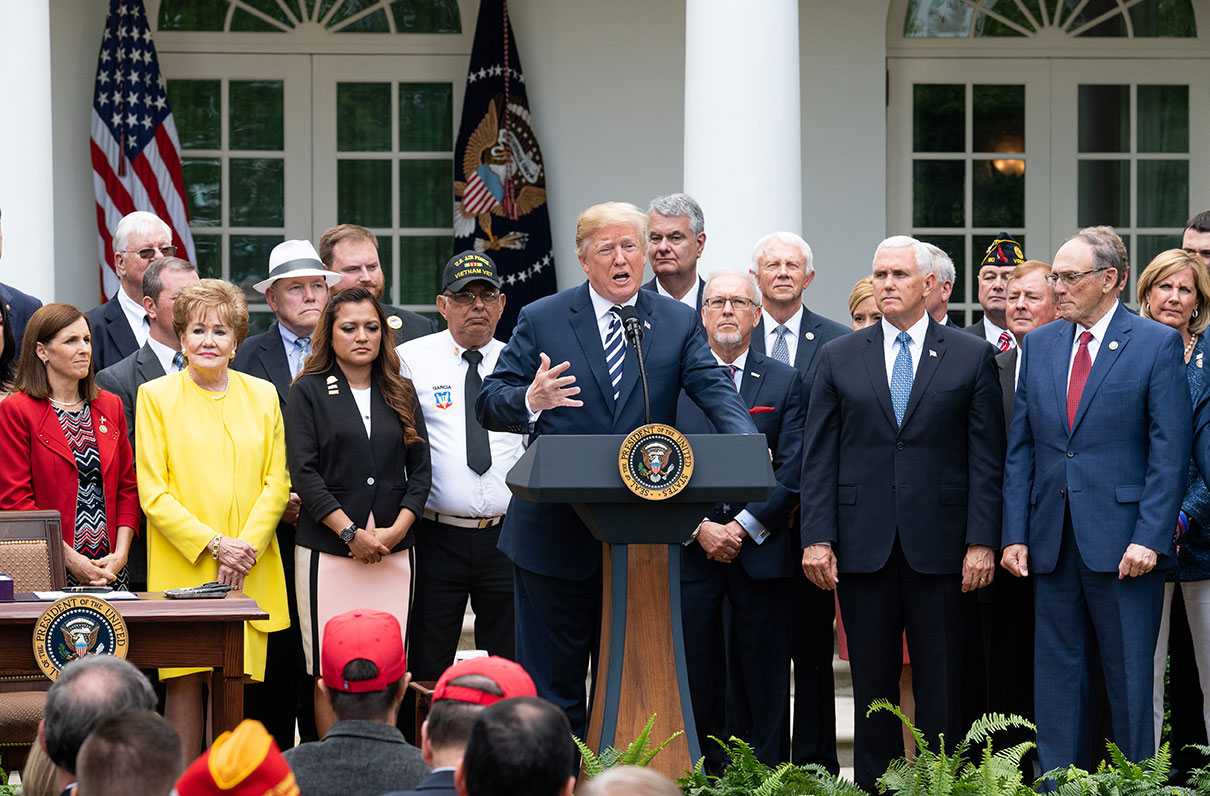(President Trump on June 6 signed the VA Mission Act. The President was joined by a number of veteran service organizations who fought for this legislation. MOAA was there for this historic event.)
June 27, 2018
After months of uncertainty, the VA received the final green light it needed to fully implement the MISSION Act when the Senate passed an appropriations bill June 25, 2018, giving the agency more than $50 billion dollars it needs to execute the massive veterans' health care reforms contained in the act.
Implementing the bill may be more difficult than it was to get President Donald Trump to sign it and then getting Congress to agree on how to fund it.
You see, there are a lot of challenges facing the VA. Any number of things could derail the plan and put at risk improving veterans' access to health care, expanding VA's comprehensive caregiver program to eligible veterans of all eras, and realigning and modernizing the department's medical facilities and infrastructure intended by Congress when it passed the MISSION Act.
Certainly MOAA will do our part to help VA navigate the myriad changes ahead, so please stay informed and engaged. More than ever, we need MOAA members to help us assess and overcome these challenges and uncertainties so we can achieve the desired outcomes we advocated for in the VA MISSION Act.
Related reading:
Trump Signs MISSION Act Reforming VA Health Care
Retiring VA Leader: MOAA Is Essential to Veterans' Health Care
The more pressing challenge is to fill the top leadership position in the department - the Secretary of VA, which has been vacant for almost two months.
“The problems start at the top,” said Ranking Member Rep. Julia Brownley (D-Calif.) at a June 21, 2018, House subcommittee oversight hearing on medical center vacancies. “The VA Secretary spot has been vacant for five weeks, and the White House only yesterday sent the nominee's paperwork to Congress … and other top positions remain vacant.”
Other pressing priorities and challenges facing VA as it prepares to implement the MISSION Act include:
- Long-term Funding and Resources. While the provisions in the MISSION Act are funded through fiscal years 2019 and 2020, VA will need sustained funding to meet the demand for veterans health care and to meet emergent operational and fiscal requirements resulting from the consolidation of seven community care programs, phase in of caregiver support services, and outcomes of a commission review of medical facilities across the health system, as well as other provisions in the law.
- Re-Establishing Trust. Four years after the waiting list crisis at the VA medical center in Phoenix, Ariz., and ensuing implementation of the problematic veterans' Choice Act to help fix these issues, the department continues to struggle with restoring trust with private providers who have had problems getting reimbursed from VA for delivering veterans' health care in the community. Further, trust must be restored with the veterans and VA employees who have had difficulty managing the program. VA has its work cut out for it in managing these expectations as it rolls out the new reforms in order to make VA a more provider-veteran-employee-friendly system.
- VA Medical Provider Shortages. VA continues to experience high turnover in its medical workforce, and challenges in incentivizing professionals to work in VA only make matters worse. The nationwide shortage of physicians and other medical professionals in certain fields and specialties exacerbates the inability for VA to hire and retain high quality people. Corroborating these issues is a GAO report highlighted at last week's House oversight hearing where the agency stated VA lacked data on the number of physicians who provided care at VA medical centers, including incomplete and/or non-existent data on the number of physician trainees or contract physicians.
Change won't happen overnight, and there is still much work and vetting to be done through the regulatory process to fully implement the MISSION Act. This work will require all stakeholders: the Administration, Congress, VSOs and MSOs, and other veterans groups to remain engaged throughout the process.
Then, throw into the mix Trump's reform plan and reorganization recommendations for VA, and you have more complexity and uncertainty ahead to complicate implementation of the MISSION Act.
On June 21, 2018, Trump released his broad-sweeping plan and recommendations to improve efficiency, effectiveness and accountability across the executive branch. The report called, Delivering Government Solutions in the 21st Century,” was the result of a presidential Executive Order 13781, signed back in March 2017. The report outlines specifics for VA reform and recommendations on pages 57 and 125 in the document above, which generally outlines ways VA will “modernize the agency by reducing bureaucracy, increasing accountability and improving delivery of services to America's Veterans and their loved ones,” according to a VA press release last week.
Stay tuned for more updates on the MISSION Act and other reform efforts through MOAA's newsletter.
